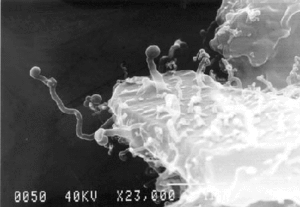Nanobe

A nanobe is a tiny filamental structure first found in some rocks and sediments. Some scientists hypothesize that nanobes are the smallest form of life, 1/10 the size of the smallest known bacteria.[1]
No conclusive evidence exists that these structures are, or are not, living organisms, so their classification is controversial. By a large margin, the majority of biologists believe observed samples to be mineral-crystalline structures rather than life-forms.
The 1996 discovery of nanobes was published in 1998[2] by Philippa Uwins et al.,[3] from the University of Queensland, Australia. They were found growing from rock samples (both full-diameter and sidewall cores) of Jurassic and Triassic sandstones, originally retrieved from an unspecified number of oil exploration wells off Australia's west coast. Depths of retrieval were between 3,400 metres (2.1 mi) and 5,100 metres (3.2 mi) below the sea bed. While Uwins et al. present assertions against it, they do not exclude the possibility that the nanobes are from a surface contaminant, not from the rock units cited.
The smallest are just 20 nanometers in diameter. Some researchers believe that these structures are crystal growths, but the staining of these structures with dyes that bind to DNA might indicate that they are living organisms.[4] They are similar to the structures found in ALH84001, a Mars meteorite found in the Antarctic. Nanobes are similar in size to nanobacteria, which are also structures that have been proposed to be extremely small living organisms. However, these two should not be confused. Nanobacteria are supposed to be cellular organisms, while nanobes are hypothesized to be a previously unknown form of life or protocells.
Claims

- It is a living organism (contains DNA or some analogue, and reproduces).
- Has a morphology similar to Actinomycetes and fungi.
- Nanobes are about 20 nm in diameter, which may be too small to contain the basic elements for an organism to exist (DNA, ribosomes, etc.), suggesting that if they grow and reproduce they would need to do so in an unconventional way.
- The Martian meteorite ALH84001, discovered in 1984 in the Antarctic, contained similar tubular structures which some astrobiologists suggested could be evidence of life at an earlier time on Mars.[5]
Responses
A review in Microbes and Environments[6] of the various ultra-small forms of proposed life states that the main criticism of nanobes is that they appear too small to contain the biochemical machinery needed to sustain life. The review also states that there is no evidence that nanobes are organisms in themselves and not fragments of larger organisms.
Tony Taylor, one of the authors of the original nanobe paper,[2] argues that the conspicuous lack of phosphorus in the X-ray spectroscopy data and the failure to find DNA using various DNA amplification techniques demonstrates that nanobes do not have any DNA or RNA and may have a completely different mechanism for heredity, which accounts for many of their unusual chemical and physical properties and renders the size argument irrelevant.
See also
- Mycoplasma genitalium, Pelagibacter ubique — some of the smallest known bacteria
- Mimivirus — one of the largest known viruses
- Nanoarchaeum — smallest known archaeum
- Nanobacterium – another proposed class of living organisms
- Parvovirus — family of the smallest known viruses
- Ultramicrobacteria
References
- ↑ Nanjundiah, V. (2000). "The smallest form of life yet?". Journal of Biosciences 25 (1): 9–10. doi:10.1007/BF02985175. PMID 10824192.
- ↑ 2.0 2.1 Uwins, Philippa, J. R. et al. (1998). "Novel nano-organisms from Australian sandstones". American Mineralogist 83: 1541–1550.
- ↑ Nanobes: About Philippa Uwins and the Discovery Team
- ↑ "Nanobacteria and Nanobes- Are They Alive?"
- ↑ McSween, H. Y. (1997). "Evidence for life in a martian meteorite?". GSA Today 7 (7): 1–7. PMID 11541665.
- ↑ Velimirov, B. (2001). "Nanobacteria, Ultramicrobacteria and Starvation Forms: A Search for the Smallest Metabolizing Bacterium". Microbes and Environments 16 (2): 67–77. doi:10.1264/jsme2.2001.67. Retrieved 2008-06-23.
External links
- Color photo of a nanobe colony
- Definition of nanobe
- Introduction to nanobes
- "Nanobes: A New Form of Life?"
- Nanobe images and links
- Transcript of interview of Philippa Uwins
- Size Limits of Very Small Microorganisms Proceedings of a Workshop organized by the National Academies of Sciences
- William J Broad (January 18, 2000). "Scientists Find Smallest Form of Life, if It Lives". The New York Times.
- How Small Can Life Be? on NAI news.